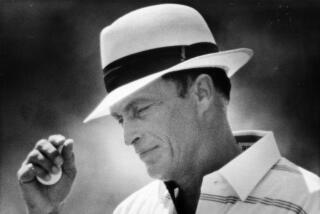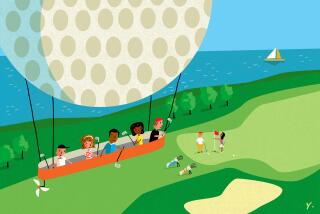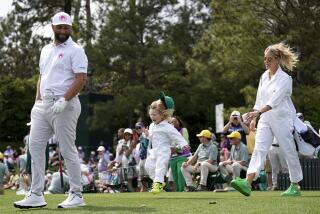COACHES’ TIPS
TOM SARGENT
Mesa Verde Country Club (Southern California PGA teacher of the year, 1995, 1993, 1986)
This will help you: Practice your short game. Most people are not very good wedge players. You have to learn how to bounce [the club], putt and chip.
This one helped me: You have to play the game until the end. You can’t ever give up. I remember thinking that over 30 years ago during a tournament on the mini-tour at Carlton Oaks in San Diego. It changed my whole outlook on things, maybe on my life.
--
EDDIE MERRINS
PGA life member, Bel-Air Country Club (Southern California PGA teacher of the year, 1987)
This will help you: Swing the handle, just like you would swing a two-handed backhander with a tennis racket. Most golfers make the mistake of swinging the club head, which make the hands too active. The forearms and the club handle should be active, [not the] hands and club head.
This one helped me: Understanding what the game is about: Move the ball from point A to point B. You need to pinpoint a target and trust the swing you brought with you. The average golfer doesn’t have their mind-set on a target. They try to hit it and hope for the best.
--
JOHN MASON
Encinitas Ranch (Southern California PGA teacher of the year, 2005)
This will help you: Get a grip. Learn how the hands influence the club head. If the hands don’t work together as a unit, [you wind up with a] slice, a top [or another wayward shot]. One hand should not overpower the other. And practice your short game.
This one helped me: Never hit a shot before you see it or feel it. See the trajectory; feel the swing you’re going to put on the ball. I take a practice swing and a waggle [as part of] my pre-shot routine.
--
JERRY ELWELL
SilverRock Resort (Southern California PGA teacher of the year, 2004)
This will help you: Most people swing too hard and have grips that are too small. One in 100 people have the right size grip [on their clubs]. This causes them to grip the club too hard and swing too hard. Sam Snead used to say, “I live in the fast lane, I swing to a waltz.” Most people swing to rock music.
This one helped me: When I was 22 years old, Byron Nelson told me the secret of consistency. You want to feel like the club head is pointing straight up at the sky [at the top of your backswing]. In reality it’s more like in the three-quarters position, but it feels like it’s pointing straight up. This helped to shorten my swing.
--
MARK MINIER
Glen Annie Golf Club (Southern California PGA teacher of the year, 2006)
This will help you: Most golfers don’t know how to square the club face properly. People think you roll your arms over one another, [but] the hands still [should be] in front of the club face [in the impact area]. If the club face gets in front of the hands, you scoop the shot.
This one helped me: The good player is not afraid of information. We know what kind of golf swing produces a certain shot. For example, to hit a high . . . draw, you take a bigger shoulder turn, take the hands farther away from the body, shallow out the swing with the hands leading and the club face square to closed. You finish up with the right shoulder, rather than the chest, pointing at the target. It’s a fallacy that you don’t think out there [on the course]. The more you know, the better off you are.
--
DON PARSONS
Twin Lakes Golf Course (Southern California PGA teacher of the year, 2003)
This will help you: Most amateurs have little control over their pelvis. You have be able to control your pelvis -- how it rotates, tilts and slides. This is an important foundation in transferring energy from the ground up through the body and the rest of the swing. This requires a certain level of fitness and we have a team of fitness trainers and medical people that screen for that.
This one helped me: Play within my own capabilities, play my own game and not someone else’s. When I was 22, I won the California Amateur [championship] without doing anything fancy. I hit my own shot, not Greg Norman’s. I’ll never be Greg Norman.
--
JAIME MULLIGAN
Virginia Country Club (Southern California PGA teacher of the year, 2000)
This will help you: The club weighs 13 ounces, the ball weighs one ounce. It doesn’t take a lot of effort to swing. We focus on rhythm; swing rather than hit . . . like a practice swing and the ball gets in the way.
This one helped me: Use your eyes. Your eyes have to pick up what goes on in any spot. Look at the course, the width of the fairways, the patterns, where you need to put the ball. You hear people ask, “How does it feel?” Vision and feel are connected.
--
ALAN OCHIAI
Oak Creek Golf Club (Southern California PGA teacher of the year, 1999)
This will help you: We’re inconsistent; we hit it some of the time. We do not have the correct alignment; the hand and club position are not correct. The shaft should be in line with the left arm . . . with the club slightly behind the hands . . . at impact. The left wrist is flat. The incline plane [between the arms and the club] should be the same from a couple of feet before the ball to a couple of feet after the ball.
This one helped me: Do not try to be perfect. You usually miss if you try that. Eighty-five percent [of perfect] is good enough. I learned in college that I did not hit it as far as some other guys, so I concentrated on staying out of trouble. Identify where the trouble is and plan not to hit it there. I let my natural draw happen and play for it.
--
ROGER GUNN
Tierra Rejada Golf Club (Southern California PGA teacher of the year, 2001)
This will help you: Keep the wrists and hands very soft and leave the club alone. Don’t try to alter the club’s speed and motion. Hold the club lightly and allow the club to swing. If the wrists are soft, they’ll hinge and unhinge when they are supposed to.
This one helped me: As a player, you understand what your strengths and weaknesses are and play accordingly. Fred Funk does not try to be Fred Couples. He hits it straight and short. Because he is so accurate, he might be able to hit a driver on some holes where others have to use an iron [to stay in the fairway].
--
BOB HARRISON
Brentwood Country Club (Southern California PGA teacher of the year, 2002)
This will help you: The next shot is your most important shot. Focus on that. That leads to more consistency and keeps emotions on a more even keel. Don’t get upset or excited about what happened a hole ago or two holes ago.
This one helped me: Have the proper preparation and good routine. When I was on tour, in the three hours from the time I woke up, I would have breakfast, take a walk, drive to the course, putt, chip and then go to the range. The last thing I would practice on the range was the first shot I would hit on the course.


